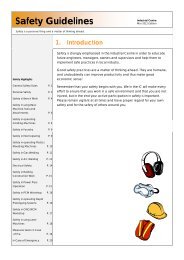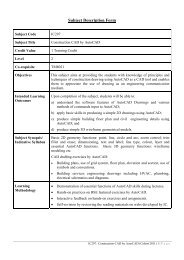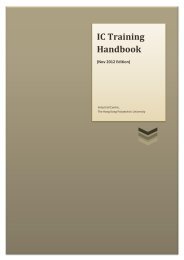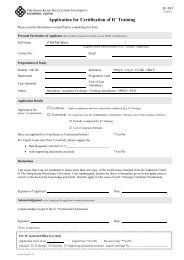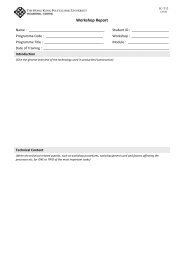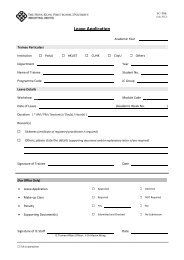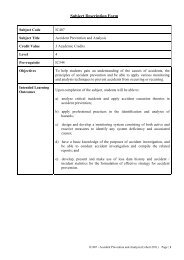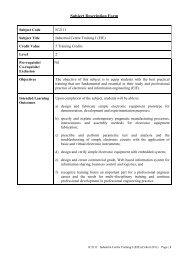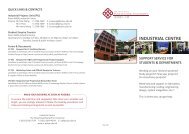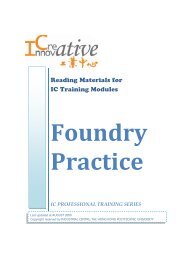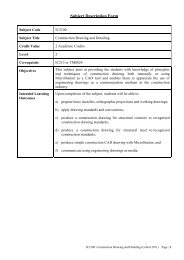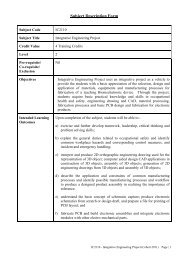Sheet Metal Fabrication - The Hong Kong Polytechnic University
Sheet Metal Fabrication - The Hong Kong Polytechnic University
Sheet Metal Fabrication - The Hong Kong Polytechnic University
You also want an ePaper? Increase the reach of your titles
YUMPU automatically turns print PDFs into web optimized ePapers that Google loves.
IC LEARNING SERIES<br />
<strong>Sheet</strong> <strong>Metal</strong><br />
<strong>Fabrication</strong>
<strong>The</strong> <strong>Hong</strong> <strong>Kong</strong> <strong>Polytechnic</strong> <strong>University</strong><br />
Industrial Centre<br />
IC LEARNING SERIES<br />
<strong>Sheet</strong> <strong>Metal</strong> <strong>Fabrication</strong><br />
Suitable for the following learning modules offered by the Industrial Centre:<br />
TM0212 Ducting and Welding Practice<br />
TM0402 <strong>Fabrication</strong> Processes Appreciation<br />
TM0412 <strong>Fabrication</strong> and Welding Practice<br />
IC235 Integrated Practical Training<br />
IC253 Introduction to Product Prototyping and <strong>Fabrication</strong> Processes<br />
IC348 Appreciation of Manufacturing Processes<br />
Last updated: May 2012<br />
Copyright reserved by Industrial Centre, <strong>The</strong> <strong>Hong</strong> <strong>Kong</strong> <strong>Polytechnic</strong> <strong>University</strong>
<strong>Sheet</strong> <strong>Metal</strong> <strong>Fabrication</strong><br />
<strong>Sheet</strong> <strong>Metal</strong> <strong>Fabrication</strong><br />
Objectives:<br />
• To recognize common manufacturing processes of <strong>Sheet</strong><br />
<strong>Metal</strong> <strong>Fabrication</strong><br />
• To recognize common material used in the industry<br />
• To understand the principles of design and fabricate of<br />
sheet metal products<br />
1. Introduction<br />
<strong>The</strong> term 'sheet metal fabrication' is generally applied to the making of articles in<br />
metal or alloy sheets within a range from 10 Gauge (3.25 mm) to 32 Gauge<br />
(0.274 mm). Broadly speaking, sheet metal fabrication may include shaping and<br />
forming of sheet metals by use of punching machines and presses. <strong>Sheet</strong> metal<br />
plays an essential role in all aspects of our everyday lives. Its many applications<br />
include use in home appliance, building construction, air conditioning, and all<br />
kinds of transportation system. Although there is a requirement for high labour<br />
content and although plastic materials are replacing sheet metal, sheet metal<br />
work is still growing. This happening related to CNC processing equipment has<br />
opened up new opportunities for the engineers as such equipment reduces the<br />
labour content in sheet metal work and improves productivity.<br />
1.1 <strong>Sheet</strong> <strong>Metal</strong> Gauge<br />
Gauge sizes are numbers that indicate the thickness of a piece of sheet metal,<br />
with a higher number referring to a thinner sheet. <strong>The</strong> equivalent thicknesses<br />
differ for each gauge size standard, which were developed based on the weight<br />
of the sheet for a given material.<br />
<strong>The</strong> Manufacturers' Standard Gage provides the thicknesses for standard steel,<br />
galvanized steel, and stainless steel. <strong>The</strong> Brown and Sharpe Gage, also known as<br />
the American Wire Gage (AWG), is used for most non ferrous metals, such as<br />
Aluminum and Brass.<br />
Gauge table of Galvanized steel<br />
Page 1<br />
IC Professional Training
<strong>Sheet</strong> <strong>Metal</strong> <strong>Fabrication</strong><br />
Thickness Weight Per Area<br />
Gauge in mm lb/ft² kg/m²<br />
10 0.1382 3.510 5.638 27.527<br />
11 0.1233 3.132 5.030 24.559<br />
12 0.1084 2.753 4.422 21.591<br />
13 0.0934 2.372 3.810 18.603<br />
14 0.0785 1.994 3.202 15.636<br />
15 0.0710 1.803 2.896 14.142<br />
16 0.0635 1.613 2.590 12.648<br />
17 0.0575 1.461 2.346 11.453<br />
18 0.0516 1.311 2.105 10.278<br />
19 0.0456 1.158 1.860 9.083<br />
20 0.0396 1.006 1.615 7.888<br />
21 0.0366 0.930 1.493 7.290<br />
22 0.0336 0.853 1.371 6.692<br />
23 0.0306 0.777 1.248 6.095<br />
24 0.0276 0.701 1.126 5.497<br />
25 0.0247 0.627 1.008 4.920<br />
26 0.0217 0.551 0.885 4.322<br />
27 0.0202 0.513 0.824 4.023<br />
28 0.0187 0.475 0.763 3.725<br />
29 0.0172 0.437 0.702 3.426<br />
30 0.0157 0.399 0.640 3.127<br />
31 0.0142 0.361 0.579 2.828<br />
32 0.0134 0.340 0.547 2.669<br />
1.2 Common <strong>Sheet</strong> <strong>Metal</strong> Materials<br />
A large quantity of material used in sheet metal work is steel rolled into sheets of<br />
various thickness and then coated with different protective materials, such as<br />
black oxide, zinc, and tin. <strong>The</strong> purpose of such a coating is to protect the steel<br />
from corroding and therefore make it last longer.<br />
1.21 Black iron sheet<br />
Black iron sheet is steel sheet coated with a thin layer of oxide to provide<br />
moderate protection against rusting. <strong>The</strong> sheets are normally used for objects<br />
that are to be painted.<br />
1.2.2 Galvanized steel sheet<br />
Galvanized sheet metal consists of soft steel sheets coated with zinc. <strong>The</strong>y can be<br />
easily recognized by its typical spangled appearance. Zinc coating is highly<br />
resistant to corrosion as long as it remains intact on the sheet. Galvanized steel<br />
will have high corrosion resistance which prevent galvanic corrosion (rusting) of<br />
the base materials, steel. <strong>The</strong> effect of this is that the zinc is consumed first as a<br />
sacrificial anode, so that it cathodically protects exposed steel. This means that in<br />
case of scratches through the zinc coating, the exposed steel will be cathodically<br />
protected by the surrounding zinc coating. Good quality galvanized steel can be<br />
bent and straightened out several times without the zinc peeling from the sheet.<br />
Page 2<br />
IC Professional Training
<strong>Sheet</strong> <strong>Metal</strong> <strong>Fabrication</strong><br />
However, if the zinc is damaged through welding, grinding, or any other process,<br />
then the steel will be exposed and this portion of the sheet will rust through very<br />
quickly. For this reason, galvanized sheet metal is seldom used in applications<br />
requiring welded joints. Of all the sheet metals, galvanized is one of the least<br />
expensive. It is probably the most commonly used of all types of sheets in the<br />
general sheet metal shop.<br />
1.2.3 Aluminium sheet<br />
Aluminium sheet can easily be recognized by its whitish appearance and by its<br />
lightness. It is often used in the sheet metal shops because of its pleasing<br />
appearance, corrosion resistance and lightness. Aluminium has also found<br />
extensive use in thousands of mass production items such as kitchenware, trailer<br />
bodies, and thousands of small parts. Pure aluminium is very soft and ductile,<br />
therefore aluminium alloy form to be used in commercial products. Aluminium<br />
alloys are from 1000 series to 7000 series. For example, the 1000 series is up to<br />
99% pure aluminium. <strong>The</strong> most common space aluminium alloy is the 2000 series.<br />
1.2.4 Stainless steel sheet<br />
Stainless steel sheet possesses untarnished surface appearance and corrosion<br />
resistance as its main advantages. It can be welded and cut without damaging its<br />
corrosion resistance. Stainless steel is very tough, but it can still be readily<br />
worked in sheet metal shop. Stainless steel sheet metal ware is extensively used<br />
in applications where high corrosion resistance is required. Stainless steel is a<br />
high grade steel to which chromium and nickel are added to the steel as the<br />
major alloying elements. Stainless steel is classified according to the alloy<br />
content and is distributed through three series numbers: the 200 series, the 300<br />
series, and the 400 series.<br />
2 Manufacturing Processes<br />
<strong>The</strong> manufacturing processes of sheet metal parts can be classified in material<br />
removal and material deformation. Material removal process can be a stage of<br />
creating a 2D shape such as a development of a sheet metal part by punching,<br />
notching, or nibbling. Deformation process can be a stage of bending or stretch<br />
sheet metal part into a 3D complex shape.<br />
2.1 Material Removal with Shear<br />
Shear is a piece of sheet metal separated by applying a force to cause the<br />
material to fail. When a great enough shearing force is applied, the shear stress<br />
in the material will exceed the ultimate shear strength and the material will fail<br />
and separate at the cut location. This shearing force is applied by two tools, one<br />
above and one below the sheet. Whether these tools are a punch and die or<br />
upper and lower blades, the tool above the sheet delivers a quick downward<br />
blow to the sheet metal that rests over the lower tool. A small clearance is<br />
Page 3<br />
IC Professional Training
<strong>Sheet</strong> <strong>Metal</strong> <strong>Fabrication</strong><br />
present between the edges of the upper and lower tools, which facilitates the<br />
fracture of the material. <strong>The</strong> size of this clearance is typically 2-10% of the<br />
material thickness and depends upon several factors, such as the specific<br />
shearing process, material, and sheet thickness.<br />
2.1.1 Shear Action<br />
<strong>The</strong> material is stressed in shear to the point of fracture while going through<br />
three phases:<br />
1. Deformation: As the cutting edges begin to close on the material, deformation<br />
occurs on both sides of the material next to the cut edge.<br />
2. Penetration: <strong>The</strong> cutting edges cut or penetrate the material, causing fracture<br />
lines.<br />
3. Fracture: <strong>The</strong> point where the upper and lower fracture lines meet. At this point<br />
the work is done, but in punching, the punch must continue to move through<br />
the material to clear the slug<br />
<strong>The</strong> shear cutting action produces four inherent characteristics found on both<br />
the parent material and the cut-off (or punched-out) part. <strong>The</strong>se characteristics<br />
are:<br />
• Plastic deformation<br />
• Vertical burnish-cut band<br />
• Angular fracture<br />
• Burr caused by the fracture starting above the cutting edge<br />
Page 4<br />
IC Professional Training
<strong>Sheet</strong> <strong>Metal</strong> <strong>Fabrication</strong><br />
2.1.2 Blanking<br />
Blanking is a cutting process in which a piece of sheet metal is removed from a<br />
larger piece of stock by applying a great enough shearing force. In this process,<br />
the piece removed, called the blank, is not scrap but rather the desired part.<br />
Blanking can be used to cut out parts in almost any 2D shape, but is most<br />
commonly used to cut work pieces with simple geometries that will be further<br />
shaped in subsequent processes. Often times multiple sheets are blanked in a<br />
single operation. Final parts that are produced using blanking include gears,<br />
jewelry, and watch or clock components. Blanked parts typically require<br />
secondary finishing to smooth out burrs along the bottom edge.<br />
2.1.3 Punching<br />
Punching is a cutting process in which material is removed from a piece of sheet<br />
metal by applying a great enough shearing force. Punching is very similar to<br />
blanking except that the removed material, called the slug, is scrap and leaves<br />
behind the desired internal feature in the sheet, such as a hole or slot. Punching<br />
can be used to produce holes and cut-outs of various shapes and sizes. <strong>The</strong> most<br />
common punched holes are simple geometric shapes (circle, square, rectangle,<br />
etc.) or combinations thereof. <strong>The</strong> edges of these punched features will have<br />
some burrs from being sheared but are of fairly good quality.<br />
2.1.4 Nibbling<br />
Page 5<br />
IC Professional Training
<strong>Sheet</strong> <strong>Metal</strong> <strong>Fabrication</strong><br />
Nibbling is a process which cuts a contour by producing a series of overlapping<br />
slits or notches. This allows for complex shapes to be formed in sheet metal part<br />
production. Punches are available in various shape and sizes; oblong and<br />
rectangular punches are common because they minimize waste and allow for<br />
greater distances between strokes, as compared to a round punch.<br />
2.1.5 CNC Turret Punch Press<br />
A CNC turret punch press machine bases on the principle of nibbling, features a<br />
unified structure into which a die turret and punch turret mounted with various<br />
punch dies, and punch respectively and a work sheet positioning mechanism are<br />
combined together. Turret punch presses are brought into run, in combination<br />
with a CNC unit.<br />
With these punch press, work sheet positioning according to the machining<br />
dimensions tor an intended product, press working, optimal operation mode<br />
selection, die and punch choosing are automatically done, following the CNC<br />
commands. <strong>The</strong>refore the CNC turret press can undertake sequentially punching<br />
different holes in a work sheet with each die and punch indexed automatically at<br />
one fixed punching position while relocating the sheet in each cycle of punching.<br />
Work sheet positioning and turret drive are optionally, controlled numerically,<br />
allowing the press to automatically punch to a complicated profile with ease.<br />
<strong>The</strong> AMADA Aries 222 Turret Press<br />
<strong>The</strong> process from diagram to part by the CNC nibbling machine<br />
Page 6<br />
IC Professional Training
<strong>Sheet</strong> <strong>Metal</strong> <strong>Fabrication</strong><br />
2.1.6 <strong>Sheet</strong> <strong>Metal</strong> Cutting without Shearing<br />
2.1.6.1 Laser beam cutting<br />
Laser cutting uses a high powered laser to cut through sheet metal. A series of<br />
mirrors and lenses direct and focus a high-energy beam of light onto the surface<br />
of the sheet where it is to be cut. When the beam strikes the surface, the energy<br />
of the beam melts and vaporizes the metal underneath. Any remaining molten<br />
metal or vapor is blown away from the cut by a stream of gas. <strong>The</strong> position of<br />
the laser beam relative to the sheet is precisely controlled to allow the laser to<br />
follow the desired cutting path.<br />
Laser cutting can be performed on sheet metals that are both ferrous and nonferrous.<br />
Materials with low reflectivity and conductivity allow the laser beam to<br />
be most effective - carbon steel, stainless steel, and titanium are most common.<br />
<strong>Metal</strong>s that reflect light and conduct heat, such as aluminum and copper alloys,<br />
Page 7<br />
IC Professional Training
<strong>Sheet</strong> <strong>Metal</strong> <strong>Fabrication</strong><br />
can still be cut but require a higher power laser. Laser cutting can also be used<br />
beyond sheet metal applications, to cut plastics, ceramics, stone, wood, etc.<br />
2.1.6.2 Plasma Cutting<br />
Plasma cutting uses a focused stream of ionized gas, or plasma, to cut through<br />
sheet metal. <strong>The</strong> plasma flows at extremely high temperatures and high velocity<br />
and is directed toward the cutting location by a nozzle. When the plasma<br />
contacts the surface below, the metal melts into a molten state. <strong>The</strong> molten<br />
metal is then blown away from the cut by the flow of ionized gas from the nozzle.<br />
<strong>The</strong> position of the plasma stream relative to the sheet is precisely controlled to<br />
follow the desired cutting path.<br />
Plasma cutting is performed with a plasma torch that may be hand held or, more<br />
commonly, computer controlled. CNC (computer numerically controlled) plasma<br />
cutting machines enable complex and precision cuts to made. In either type of<br />
plasma torch, the flow of plasma is created by first blowing an inert gas at high<br />
speed though a nozzle pointed at the cutting surface. An electrical arc, formed<br />
through the flow of gas, ionizes the gas into plasma. <strong>The</strong> nozzle then focuses the<br />
flow of plasma onto the cut location. As with laser cutting, this process does not<br />
require any physical tooling which reduces initial costs and allows for cost<br />
effective low volume production.<br />
<strong>The</strong> capabilities of plasma cutting vary slightly from laser cutting. While both<br />
processes are able to cut nearly any 2D shape out of sheet metal, plasma cutting<br />
cannot achieve the same level of precision and finish. Edges may be rough,<br />
especially with thicker sheets, and the surface of the material will have an oxide<br />
layer that can be removed with secondary processes. However, plasma cutting is<br />
capable of cutting through far thicker sheets than laser cutting and is often used<br />
for work pieces beyond sheet metal.<br />
2.1.6.3 Water jet cutting<br />
Water jet cutting uses a high velocity stream of water to cut through sheet metal.<br />
<strong>The</strong> water typically contains abrasive particles to wear the material and travels in<br />
a narrow jet at high speeds, around 2000 ft/sec. As a result, the water jet applies<br />
very high pressure (around 60,000 psi) to the material at the cut location and<br />
quickly erodes the material. <strong>The</strong> position of the water jet is typically computer<br />
controlled to follow the desired cutting path.<br />
Water jet cutting can be used to cut nearly any 2D shape out of sheet metal. <strong>The</strong><br />
width of the cuts is typically between 0.002 and 0.06 inches and the edges are of<br />
good quality. Because no burrs are formed, secondary finishing is usually not<br />
required. Also, by not using heat to melt the material, like laser and plasma<br />
cutting, heat distortion is not a concern.<br />
Page 8<br />
IC Professional Training
<strong>Sheet</strong> <strong>Metal</strong> <strong>Fabrication</strong><br />
2.2 <strong>Sheet</strong> <strong>Metal</strong> Forming<br />
<strong>Sheet</strong> metal forming processes are those in which force is applied to a piece of<br />
sheet metal to modify its geometry rather than remove any material. <strong>The</strong> applied<br />
force stresses the metal beyond its yield strength, causing the material to<br />
plastically deform, but not to fail. By doing so, the sheet can be bent or stretched<br />
into a variety of complex shapes. <strong>Sheet</strong> metal forming processes include the<br />
following:<br />
Bending<br />
Roll forming<br />
Spinning<br />
Deep Drawing<br />
Stretch forming<br />
2.2.1 Bending<br />
Bending is a metal forming process in which a force is applied to a piece of sheet<br />
metal, causing it to bend at an angle and form the desired shape. A bending<br />
operation causes deformation along one axis, but a sequence of several different<br />
operations can be performed to create a complex part. A bend can be<br />
characterized by several different parameters, shown in the image below.<br />
2.2.1.1 Neutral axis and development length<br />
<strong>The</strong> neutral axis is the line of zero stress and strain in a bend with tension on one<br />
surface and compression on the other. Before bending, the flat blank is of a<br />
certain length, and the length of the neutral axis is exactly equal to this original<br />
blank length. During bending, the outside surface of the sheet metal is increased<br />
Page 9<br />
IC Professional Training
<strong>Sheet</strong> <strong>Metal</strong> <strong>Fabrication</strong><br />
in length, and the inside surface of the sheet metal is decreased in length, but<br />
the length of the neutral axis remains the same. Because the neutral axis is a true<br />
representation of the original blank length, it is used for blank-development<br />
calculations. Following is the formula to calculate the original length of the sheet<br />
metal before bending.<br />
2.2.1.2 Spring Back<br />
<strong>The</strong> metal nearest the neutral axis has been stressed to values below the elastic<br />
limit. This metal creates a narrow elastic band on both sides of the neutral axis,.<br />
<strong>The</strong> metal farther away from the axis has been stressed beyond the yield<br />
strength, however, and has been plastically or permanently deformed. When the<br />
die opens, the elastic band tries to return to the original flat condition but<br />
cannot, due to restriction by the plastic deformation zones. Some slight return<br />
does occur as the elastic and plastic zones reach an equilibrium, and this return is<br />
known as springback.<br />
Page 10<br />
IC Professional Training
<strong>Sheet</strong> <strong>Metal</strong> <strong>Fabrication</strong><br />
Methods are used to overcome or counteract the effects of springback:<br />
• Overbending<br />
• Bottoming or setting<br />
• Stretch bending<br />
2.2.1.2.1 Overbending<br />
Overbending may be accomplished by using cams, by decreasing the die<br />
clearance, or by setting the punch and die steels at a smaller angle than required<br />
in the case of a V-die. When the clearance is reduced below the sheet metal<br />
thickness, the burnishing action wipes the metal against an undersized punch or<br />
die steel.<br />
2.2.1.2.2 Bottoming<br />
Bottoming or setting consists of striking the metal severely at the radius area.<br />
This places the metal under high compressive stresses that set the metal past the<br />
yield strength. Bottoming is accomplished by placing a bead on the punch at the<br />
bend area. In a wiping die or U-die, the pad must bottom against the shoe or<br />
backing plate so that the punch may set the metal at the bend. It would be<br />
useless to bottom against the flat areas of sheet metal, because they are not<br />
stressed and do not cause springback. Also, bottoming against these larger areas<br />
would require extremely high press tonnages. Bottoming must be carefully<br />
controlled when adjusting the press ram, or the forces involved will rise at a rapid<br />
rate. Also, if two blanks are accidentally placed in a bending die that bottoms,<br />
press or die breakage may result.<br />
2.2.1.2.3 Stretch bending<br />
Stretch bending consists of stretching the blank so that all the metal is stressed<br />
past the yield strength. <strong>The</strong> blank is then forced over the punch to obtain the<br />
desired contour. This prestressing before bending results in very little springback.<br />
Page 11<br />
IC Professional Training
<strong>Sheet</strong> <strong>Metal</strong> <strong>Fabrication</strong><br />
Only relatively large radii are bent by this method, because sharp radii would<br />
take the prestressed metal beyond the ultimate tensile strength. <strong>The</strong> sheet metal<br />
must be uniform in strength. Any weak spots or defects will certainly cause<br />
failure. Stretch bending is most frequently done with a special hydraulic machine<br />
rather than with a die in a press. Hourly production rates are slower for such<br />
machines than for presses.<br />
2.2.2 Press Brakes<br />
Press Brakes are a common type of equipment for bending metal by delivering<br />
an accurate vertical force in a confined longitudinal area. Any metal that can be<br />
punched or bent by other processes can be formed on a press brake. Press<br />
brakes are manually fed by an operator. <strong>The</strong> operator holds a metal workpiece<br />
between a punch and die and against a gage to apply a bend or multiple bends<br />
to the metal workpiece. Press brakes can have one of several types of back gages,<br />
depth stops, and pins to engage holes in the workpiece. Gages can be manually<br />
placed and adjusted, or computer numerically controlled programmable units<br />
can automatically adjust settings after each stroke.<br />
A CNC Press Brake<br />
Page 12<br />
IC Professional Training
<strong>Sheet</strong> <strong>Metal</strong> <strong>Fabrication</strong><br />
2.3 Roll Forming<br />
Roll forming is a metal forming process in which sheet metal is progressively<br />
shaped through a series of bending operations. <strong>The</strong> process is performed on a<br />
roll forming line in which the sheet metal stock is fed through a series of roll<br />
stations. Each station has a roller, referred to as a roller die, positioned on both<br />
sides of the sheet. <strong>The</strong> shape and size of the roller die may be unique to that<br />
station, or several identical roller dies may be used in different positions. <strong>The</strong><br />
roller dies may be above and below the sheet, along the sides, at an angle, etc.<br />
As the sheet is forced through the roller dies in each roll station, it plastically<br />
deforms and bends. Each roll station performs one stage in the complete<br />
bending of the sheet to form the desired part. <strong>The</strong> roller dies must be lubricated<br />
to reduce friction between the die and the sheet, thus reducing the tool wear.<br />
Also, lubricant can allow for a higher production rate, which will also depend on<br />
the material thickness, number of roll stations, and radius of each bend. <strong>The</strong> roll<br />
forming line can also include other sheet metal fabrication operations before or<br />
after the roll forming, such as punching or shearing.<br />
2.4 Spinning<br />
Spinning, sometimes called spin forming, is a metal forming process used to<br />
form cylindrical parts by rotating a piece of sheet metal while forces are applied<br />
to one side. A sheet metal disc is rotated at high speeds while rollers press the<br />
sheet against a tool, called a mandrel, to form the shape of the desired part.<br />
Spun metal parts have a rotationally symmetric, hollow shape, such as a cylinder,<br />
cone, or hemisphere. Examples include cookware, hubcaps, satellite dishes,<br />
rocket nose cones, and musical instruments.<br />
Spinning is typically performed on a manual or CNC lathe and requires a blank,<br />
mandrel, and roller tool. <strong>The</strong> blank is the disc-shaped piece of sheet metal that is<br />
pre-cut from sheet stock and will be formed into the part. <strong>The</strong> mandrel is a solid<br />
form of the internal shape of the part, against which the blank will be pressed.<br />
For more complex parts, multi-piece mandrels can be used.<br />
2.5 Deep drawing<br />
Deep drawing is a metal forming process in which sheet metal is stretched into<br />
the desired part shape. A tool pushes downward on the sheet metal, forcing it<br />
into a die cavity in the shape of the desired part. <strong>The</strong> tensile forces applied to the<br />
sheet cause it to plastically deform into a cup-shaped part. Deep drawn parts are<br />
characterized by a depth equal to more than half of the diameter of the part.<br />
<strong>The</strong>se parts can have a variety of cross sections with straight, tapered, or even<br />
curved walls, but cylindrical or rectangular parts are most common. Deep<br />
drawing is most effective with ductile metals, such as aluminum, brass, copper,<br />
and mild steel. Examples of parts formed with deep drawing include automotive<br />
bodies and fuel tanks, cans, cups, kitchen sinks, and pots and pans.<br />
Page 13<br />
IC Professional Training
<strong>Sheet</strong> <strong>Metal</strong> <strong>Fabrication</strong><br />
2.6 Stretch forming<br />
Stretch forming is a metal forming process in which a piece of sheet metal is<br />
stretched and bent simultaneously over a die in order to form large contoured<br />
parts. Stretch forming is performed on a stretch press, in which a piece of sheet<br />
metal is securely gripped along its edges by gripping jaws. <strong>The</strong> gripping jaws are<br />
each attached to a carriage that is pulled by pneumatic or hydraulic force to<br />
stretch the sheet. <strong>The</strong> tooling used in this process is a stretch form block, called a<br />
form die, which is a solid contoured piece against which the sheet metal will be<br />
pressed. <strong>The</strong> most common stretch presses are oriented vertically, in which the<br />
form die rests on a press table that can be raised into the sheet by a hydraulic<br />
ram. As the form die is driven into the sheet, which is gripped tightly at its edges,<br />
the tensile forces increase and the sheet plastically deforms into a new shape.<br />
Horizontal stretch presses mount the form die sideways on a stationary press<br />
table, while the gripping jaws pull the sheet horizontally around the form die.<br />
3 Joining of <strong>Sheet</strong> <strong>Metal</strong><br />
3.1 Seam Joints<br />
In sheet metal construction there are a variety of methods for joining the edges<br />
of sheet metal. <strong>The</strong>se methods may be classified as mechanical and welded. <strong>The</strong><br />
choice of the seam is determined primarily by the thickness of the metal, the<br />
kind of metal, the cost of fabrication, and the equipment available for making the<br />
seam. However, it is obvious that the mechanical seam is used when joining light<br />
and medium gage metal, and that for heavier metal, a riveted or welded seam is<br />
necessary.<br />
Page 14<br />
IC Professional Training
<strong>Sheet</strong> <strong>Metal</strong> <strong>Fabrication</strong><br />
Processes in making a<br />
Grooved Flat Lock Seam<br />
3.1.1 Pittsburgh Seam<br />
This seam is sometimes called a hammered lock or hobo lock. It is used as a<br />
longitudinal corner seam for variously shaped pipes. <strong>The</strong> seam consists of two<br />
parts, the single lock as in (A) of Fig. 18, and the pocket lock at (B). <strong>The</strong> single<br />
lock is placed in the pocket lock, (C) and the flange is hammered over.<br />
3.2 Riveting<br />
Rivet joints are used where strength is required or when the metal sheet is too<br />
thick to be handled by seam joints. A successful riveting depends on the<br />
condition and size of the rivet holes and on the correct size and spacing of the<br />
rivet. <strong>The</strong> hole of the rivet may be punched or drilled, depending on the<br />
thickness of the metal. Thin sheet metal is usually punched, while the heavier<br />
metal thicker metal is drilled. Riveting may be done by hand or by machine.<br />
3.2.1 Type of rivets<br />
<strong>The</strong>re are many types of rivets used in sheet metal work. <strong>The</strong> four most common<br />
types are the tinners’ flathead, roundhead, and countersunk head. <strong>The</strong><br />
countersunk head is used when a flush surface is desired, and the roundhead<br />
when exceptional strength is required.<br />
Page 15<br />
IC Professional Training
<strong>Sheet</strong> <strong>Metal</strong> <strong>Fabrication</strong><br />
<strong>Sheet</strong> metal riveting is carried out in four steps.<br />
1. Drilling. Drill or punch the holes through the metals to be joined.<br />
2. Drawing. Insert the rivet into the metal and place it on a stake. Centre the hole<br />
in the rivet set over the rivet and tap the set a few times with the hammer. This<br />
operation will draw the rivet and the metal tightly together.<br />
3. Upsetting. Tap the shank of the rivet with a hammer until the shank spreads to<br />
the approximate size of the head required.<br />
4. Heading. Place the dimple of the rivet set over the rivet. Tap the rivet set over<br />
the rivet. Tap the rivet set with the hammer until the head is formed on the rivet.<br />
3.2.2 Blind rivets<br />
Blind rivets are mainly used when access to the joint is only available from one<br />
side. <strong>The</strong> rivet is placed in a pre-drilled hole and is set by pulling the mandrel<br />
head into the rivet body, expanding the rivet body and causing it to flare against<br />
the reverse side. As the head of the mandrel reaches the face of the blind side<br />
material, the pulling force is resisted, and at a predetermined force, the mandrel<br />
will snap at its break point, also called "Blind Setting". A tight joint formed by the<br />
rivet body remains, the head of the mandrel remains encapsulated at the blind<br />
side, although variations of this are available, and the mandrel stem is ejected<br />
3.3 Spot welding<br />
Spot welding is a resistance welding method used to join two to three<br />
overlapping metal sheets, studs, projections, electrical wiring hangers, some heat<br />
exchanger fins, and some tubing. Usually power sources and welding equipment<br />
are sized, to the specific thickness and material being welded together. <strong>The</strong><br />
thickness is limited by the output of the welding power source and thus the<br />
equipment range due to the current required for each application. Care is taken<br />
to eliminate, contaminates between the faying surfaces. Usually, two copper<br />
electrodes are simultaneously used to clamp the metal sheets together and to<br />
pass current through the sheets. When the current is passed through the<br />
electrodes to the sheets, heat is generated due to the higher electrical resistance<br />
where the surfaces contact each other. As the electrical resistance of the material<br />
causes heat build-up in the work between the copper electrodes, the rising<br />
temperature causes a rising resistance, and results in a molten pool contained<br />
most of the time between the electrodes.<br />
3.4 Clinching<br />
Clinching is a mechanical fastening method to join sheet metal without<br />
additional components using special tools to plastically form a mechanical<br />
interlock between the sheet metals.<br />
Page 16<br />
IC Professional Training
<strong>Sheet</strong> <strong>Metal</strong> <strong>Fabrication</strong><br />
<strong>The</strong> tools consist typically of a punch and a die. <strong>The</strong>re are two primary types of<br />
dies: solid "fixed cavity" dies, and dies with moving components. <strong>The</strong> punch<br />
forces the two layers of sheet metal into the die cavity forming a permanent<br />
connection. <strong>The</strong> pressure exerted by the punch forces the metal to flow laterally.<br />
Clinching is used primarily in the automotive, appliance and electronic industries,<br />
where it replaces spot welding very often. Clinching is a cold forming process<br />
and does not require electricity or cooling of the electrodes commonly<br />
associated with spot welding. Also, clinching does not generate sparks and<br />
fumes. In addition, the strength of a clinched joint can be tested nondestructively<br />
using a simple measuring instrument to measure the remaining<br />
thickness at the bottom of the joint or the diameter of the produced button<br />
depending on the type of tools being used. Life expectancy for clinching tools is<br />
in the hundreds of thousands of cycles making it a very economical process.<br />
Clinching Processes<br />
References:<br />
Donald F Eary, Edward A. Reed (1974), Techniques of Pressworking <strong>Sheet</strong> <strong>Metal</strong>, Prentice-<br />
Hall, INC, Englewood Cliffs, New Jersey.<br />
Z.Marciniak, JL Duncan, SJ Hu (2002), Mechanics For <strong>Sheet</strong> <strong>Metal</strong> Forming, Butterworth-<br />
Heinemann 2002<br />
Blackburn & Cassidy, <strong>Sheet</strong> <strong>Metal</strong> Work, Edward Arnold (Publishers) Ltd.<br />
Leroy F Bruce, <strong>Sheet</strong> <strong>Metal</strong> Shop Practice, American technical society<br />
www.eckold.com<br />
www.amada.com<br />
• Last Updated: May 12<br />
Page 17<br />
IC Professional Training



